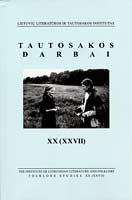Šiuolaikinės lietuvių muzikos ryšiai su tradicijomis
Relations of modern lithuanian music and traditions
Author(s): Austė NakienėSubject(s): Customs / Folklore
Published by: Lietuvių literatūros ir tautosakos institutas
Keywords: Lithuanian composers‘ school; minimalism; tradition
Summary/Abstract: In the 21st century it’s increasingly evident that certain cultural phenomena are spread globally instead of belonging to some definite places only. Some others are nevertheless still thinly linked to certain local areas. Although being local, they are rather unlikely to be still traditional. People can obtain information regardless of their place of residence, and many prefer various exotic styles to the local ones. Concept of cultural pluralism recently became predominant. The question is, whether we could expect the young generation to care about the ancient heritage and study it? Could some local styles be socially appreciated and continuously developed? In the 20th century Lithuania, traditions were not extinct and modernity not yet established. Such paradoxical situation lasted until the 90s. Consequently quite a number of traditional features can be noticed in development of Lithuanian national composers’ school. Lithuanian composers were denied possibility of studying abroad in Soviet times; therefore composition techniques were passed from the older generations to the younger ones. Lithuanian society developed acute sense of dangerously losing its national identity; therefore composers tried to device national way of music making and created elaborate local music styles according to the modern ideas of composition. The so-called Lithuanian minimalism formed in 70s and 80s. It was based on canon and other polyphonic forms, repetition and variation of rhythmic formulae and gradual increase of texture closeness. It stemmed from Lithuanian sutartinės, Renaissance polyphony and avant-garde compositions. In progressive structural changes and meditative mood this style was similar to American minimalism. It would even be reasonable to suppose that American minimalism had influenced the Lithuanian one, but in fact the national style was only renewed and enriched by the American one. In 80s, music by Terry Riley, Steve Reich, Philip Glass, and Meredith Monk was very popular in private spaces, and later, when Lithuania regained independence, it also became a great success in concert halls. In the 21st century, phenomena like Lithuanian composers’ school or national style of music ceased their existence. With growing international communication, Lithuanian authors become increasingly interested in the global cultural flows rather than in the national culture that has nourished them, they enjoy possibilities of picking up techniques, conceptions, symbols and metaphors from the whole art history. Contemporary authors have to be aware of the global art processes; they have also to consider themes of concerts and festivals, which are often adjusted to the public tastes. As result of different policies of festival organization in various countries, public tastes develop in different ways, thus the same composition could make a great success at one festival and a total failure at another...
Journal: Tautosakos darbai
- Issue Year: 2004
- Issue No: 27
- Page Range: 89-95
- Page Count: 7
- Language: Lithuanian

